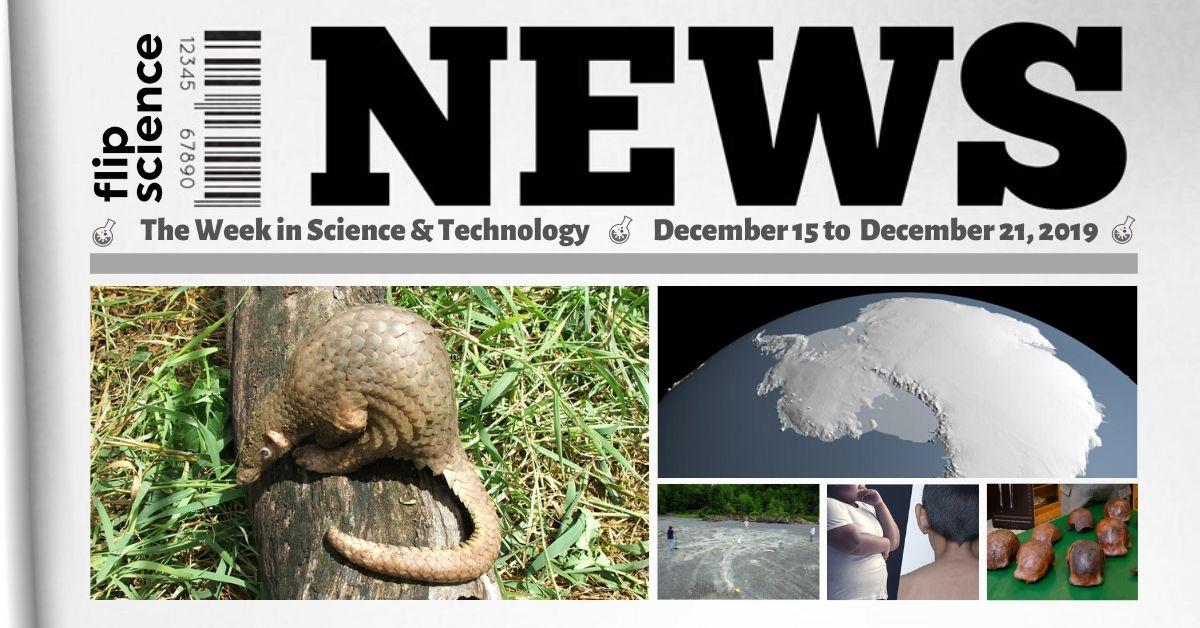ICYMI: Science and technology updates from December 15 to 21, 2019.
Philippine pangolin now classified as ‘critically endangered’
From Mongabay:
Of the eight known species of pangolins, one of the world’s most trafficked mammals, two African species, the while-bellied (Phataginus tricuspis) and the giant ground pangolin (Smutsia gigantea), have been moved from “vulnerable” to “endangered” on the IUCN Red List.
One Asian species, the Philippine pangolin (Manis culionensis), has been uplisted from “endangered” to “critically endangered”, according to the latest update by the International Union for Conservation of Nature (IUCN).
The other species remain in their respective threatened categories and haven’t improved in status.
Obesity and undernourishment: A one-two combo hitting 1/3 of the world
From Rappler:
Low- and middle-income countries risk seeing their development progress slashed by the double-edged sword of obesity and undernutrition, both caused by a lack of access to affordable healthy food, a report in The Lancet warned Monday, December 16.
This “double burden of malnutrition,” or DBM, affects more than a third of some 130 countries classed as low-and middle-income, the report in the medical journal said.
More alarming, it is increasingly seen in the same household – most commonly an overweight mother and a child stunted by undernutrition living under the same roof.
Both forms of malnutrition are linked to health problems and premature death, weighing heavily on a country’s health system and labor productivity.
The report, compiled in collaboration with the World Health Organization, said being overweight can no longer be considered a rich country problem, nor undernourishment a preserve of the poor.
Was the world’s oldest forest in New York?
From Phys.org:
Scientists have discovered remnants of the world’s oldest fossil forest in a sandstone quarry in Cairo, New York.
It is believed the extensive network of trees, which would have spread from New York all the way into Pennsylvania and beyond, is around 386 million years old.
This makes the Cairo forest around 2 or 3 million years older than what was thought to be the world’s oldest forest at Gilboa, also in New York State and around 40 km away from the Cairo site.
The new findings, which [were recently published] in the journal Current Biology, have thrown new light on the evolution of trees and the transformative role they played in shaping the world we live in today.
Earth’s deepest land canyon found under Antarctic ice
From Science Alert:
Now, a detailed map of Antarctica’s peaks and valleys has uncovered the deepest land canyon on Earth, in a narrow region known as Denman Glacier.
Stretching more than 3,500 metres (11,500 feet) below sea level, the land beneath this ice stream is nearly as deep as the average depth of the ocean, and eight times deeper than the shores of the Dead Sea, which is the lowest exposed land on Earth.
Previous airborne surveys over Antarctica relied mainly on radar and were not able to measure this trough’s full depth. Whereas the newly released map, called BedMachine, can reach further under the ice than ever before.
When did Homo erectus die out? These scientists may have the answer
From Smithsonian Magazine:
Homo erectus was a very successful early human, spreading across the ancient world and surviving Earth’s changing environments for nearly two million years—at least five times longer than our own species has been around.
Now, scientists may have pinpointed where and when Homo erectus made a final stand. The youngest known fossils of the long-lived species were identified on the Indonesian island of Java, where a dozen skulls found before World War II have finally been definitively dated to between 108,000 and 117,000 years ago.
Those dates mark the end of a long run. Homo erectus was the first known human species to evolve modern body proportions—including shorter arms and longer legs that indicate an upright walking lifestyle that permanently traded the trees for the ground. The close relative to Homo sapiens was also the first hominin known to leave Africa, and Homo erectus spread more widely than any other human species except our own. The fossils of H. erectus have been found in Western Asia (Georgia), Eastern Asia (China), and, thanks to a land bridge during a glaciated era of low sea levels, the islands of Indonesia, where the species persisted longest.
References:
- https://news.mongabay.com/2019/12/three-pangolin-species-closer-to-extinction-iucn/
- https://www.rappler.com/science-nature/247284-burden-obesity-undernourishment-stalks-world
- https://phys.org/news/2019-12-scientists-uncover-world-oldest-forest.html
- https://www.sciencealert.com/the-world-s-deepest-canyon-has-been-discovered-underneath-antarctica-s-ice-sheet
- https://www.smithsonianmag.com/science-nature/fossils-some-last-homo-erectus-hint-end-long-lived-species-180973816/







